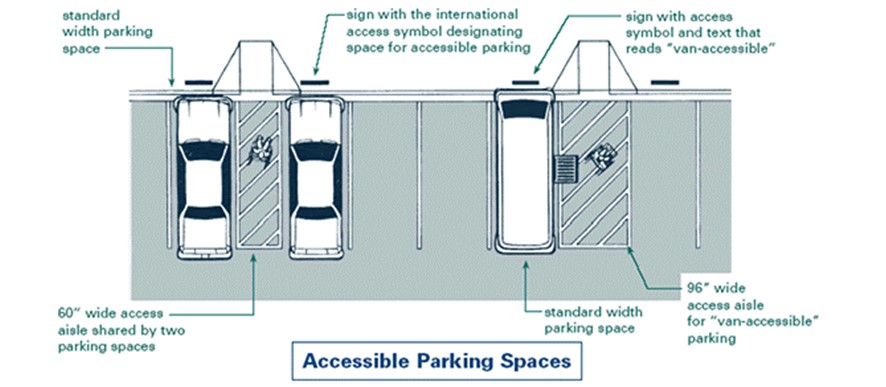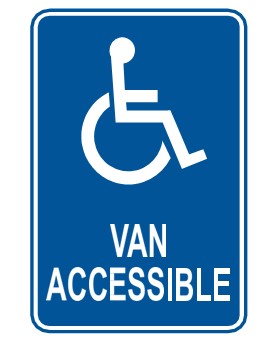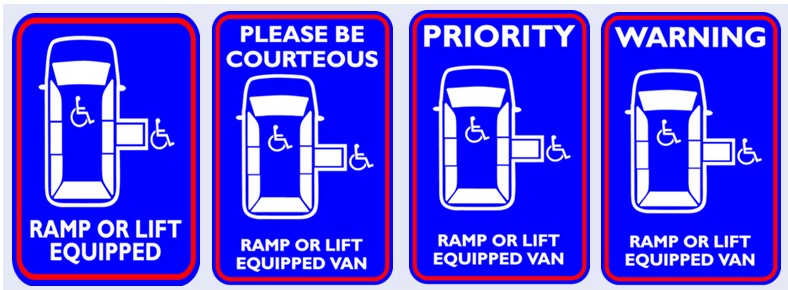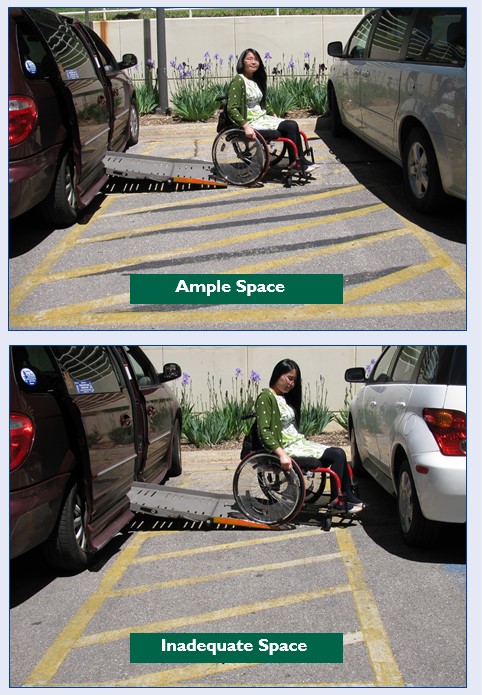Parking Equity: Encouraging Reservation of Van-Designated Spaces for Lift- or Ramp-Equipped Van Users
This information is available in PDF format upon request.
Wheelchair users who travel in a ramp- or lift-equipped van (RLEV) often reach their destination only to find the van-accessible parking space occupied by a non-ramp or lift-equipped vehicle (NRLEV) that does not need the wider access aisle placed next to van-accessible spaces. This study found that alternate signage for van-accessible parking spaces can prompt drivers of vehicles without ramps or lifts to use a regular accessible space when available, reserving the van-accessible space for RLEV users.
Background: Why It Matters
The ability to safely park at one’s destination is an important component of community participation for people with disabilities. With the proper permit, wheelchair users and other people with disabilities are entitled to use accessible parking spaces in public parking lots.
But not all accessible spaces are alike. Some are designated “Van Accessible” because they have a wider access aisle next to the parking spot. This eight-foot-wide aisle provides enough space for a person who uses a ramp- or lift-equipped vehicle to lower the ramp or lift, then maneuver safely in the area between vehicles. In contrast, access aisles next to standard accessible parking spaces are only five feet wide, which is not enough room for wheelchair users to safely disembark from or re-enter a van that has a lift or ramp.

What Does “Van Accessible” Mean?
 A sign with the words “Van Accessible” and the international symbol of accessibility (see photo at right) means the parking space is designed for ramp- or lift-equipped vehicles (RLEVs).
A sign with the words “Van Accessible” and the international symbol of accessibility (see photo at right) means the parking space is designed for ramp- or lift-equipped vehicles (RLEVs).
The photos below illustrate the purpose of van-accessible spaces. The wider aisle intended for an RLEV provides ample room for a wheelchair user to exit or enter the van and maneuver her wheelchair, without interference from the vehicle parked in the next space.
In contrast, the narrower access aisle next to a standard accessible space does not allow the user of a manual or power wheelchair to safely disembark. The individual could possibly injure her legs or feet on the neighboring vehicle, or damage her wheelchair tires by rolling over the edge of the ramp.
We know that wheelchair-users who travel in a ramp- or lift-equipped vehicle (RLEV) often find that the van-accessible parking space they need is occupied by a non-ramp- or lift-equipped vehicle (NRLEV) when a standard accessible spot is open. Based on anecdotal evidence about this problem, we conducted two studies to answer these questions:
- How significant is the problem of van-accessible parking spaces being taken by non-ramp- or lift-equipped vehicles?
- Can different signage for designated van-accessible parking spaces better prompt NRLEV drivers who have accessible parking permits to park in other accessible spaces not designated for vans?
Study One: Significance of the Problem
We conducted a focus group with 12 participants who use RLEVs to determine whether or not the use of designated van accessible parking spaces by NRLEV users is a significant problem. This group included six males and six females. Ten were people with disabilities and two were caregivers who drove for the wheelchair user. The group ranged in age from 31 to 69.
Focus Group Findings: Participants agreed that NRLEV use of van-accessible parking is a common problem that requires them to alter their own parking behavior in ways that can compromise safety. This includes: backing into a standard-size space to position the ramp door next to the wider access aisle; parking further from the store or other destination, where vehicles are scarce; or straddling two regular parking spaces to guarantee room for the ramp or lift to be safely used.
We also conducted brief interviews with 10 NRLEV users who parked in the designated van-accessible parking space at one grocery store in a mid-size Midwestern city. Questions centered on whether the drivers understood the difference between the regular accessible parking signs and the van-accessible signs.
Interview Findings: Drivers of NRLEVs reported confusion about the purpose of the “Van Accessible” designation. This reveals a need to educate drivers who have accessible parking permits on the purpose of such spaces. New or expanded signage for designated van-accessible parking spaces could be part of this education.

Study Two: Experiment with Alternate Signage
We learned in Study One that the meaning of the current “Van Accessible” sign is not clear to many drivers who have accessible parking permits. Would different signage encourage NRLEV users to avoid parking in van-accessible parking spaces if other accessible spaces were available?
We conducted an experimental study to compare the effects of four different signs on NRLEV users at two grocery stores, Store A and Store B, in the same city mentioned in Study One. We replaced the current “Van Accessible” sign with four specially designed signs with different messages, alternating the signs over a four-month observation period.
All signs (pictured above) show a graphic of a van with the lift lowered and an icon of a wheelchair user inside the van and at the end of the ramp. One sign had the words “Ramp or Lift Equipped” only at the bottom. The other three signs had the words “Ramp or Lift Equipped Van” at the bottom of the sign, plus one of these messages at the top: “Please Be Courteous,” “Priority,” and “Warning.”
Findings: The signage interventions had small to moderate effects in deterring NRLEV users from parking in designated van-accessible parking spaces. The “Please Be Courteous” sign was most effective at Store A; the “Warning” sign was most effective at Store B.
Research Methods: The researchers and four trained observers noted driver responses to each sign. They observed the drivers either from a parked vehicle or from an unobtrusive location near the front of each store, about 15-20 meters from the observed spot. A multiple component analysis was used to identify which sign worked most effectively on each site. Then a reversal design was conducted using the signs that were identified from the previous analysis to confirm the intervention effects.

Lessons Learned
This problem is of critical importance for community participation and inclusion of RLEV users, especially considering that the number of RLEV users is increasing with an aging population.
The signage intervention produced a small to moderate effect in reducing the occurrences of NRLEVs using designated van-accessible parking spaces, thus increasing the opportunity for RLEV users to park. However, the most effective sign varied by location.
Factors contributing to the current problem include lack of awareness about the purpose of van-accessible spaces and no history of consequences for NRLEV drivers parking in designated van-accessible spaces.
Directions for Future Research
Conduct additional focus groups and interviews of both NRLEV and RLEV users across rural and urban areas to gain more information.
- Implement intervention studies in more diverse settings such as hospital and university campus parking lots to develop a sign that works effectively in general.
Implications for Change
- Revise public policies. Two options are possible:
- Provide universal access – i.e., wider access aisles for all accessible parking spaces.
- Make a clearer differentiation between regular accessible parking spaces and van-accessible spaces, along with contingencies for NRLEV drivers who park in designated van-accessible parking spaces.
- Conduct an education campaign among the disability community to raise awareness about the rationale for and usage of designated van-accessible parking spaces.
- Advocate for information about accessible parking to be included in state tests for driver education and licensing and for those receiving or renewing their accessible parking plates or placards.
The contents of this publication were developed under a grant from the Department of Education, National Institute on Disability and Rehabilitation Research grant number H133B110006. However, those contents do not necessarily represent the policy of the Department of Education, and you should not assume endorsement by the Federal Government.
Project Investigators: At the University of Kansas Glen W. White, PhD; E (Alice) Zhang, MEd, MA